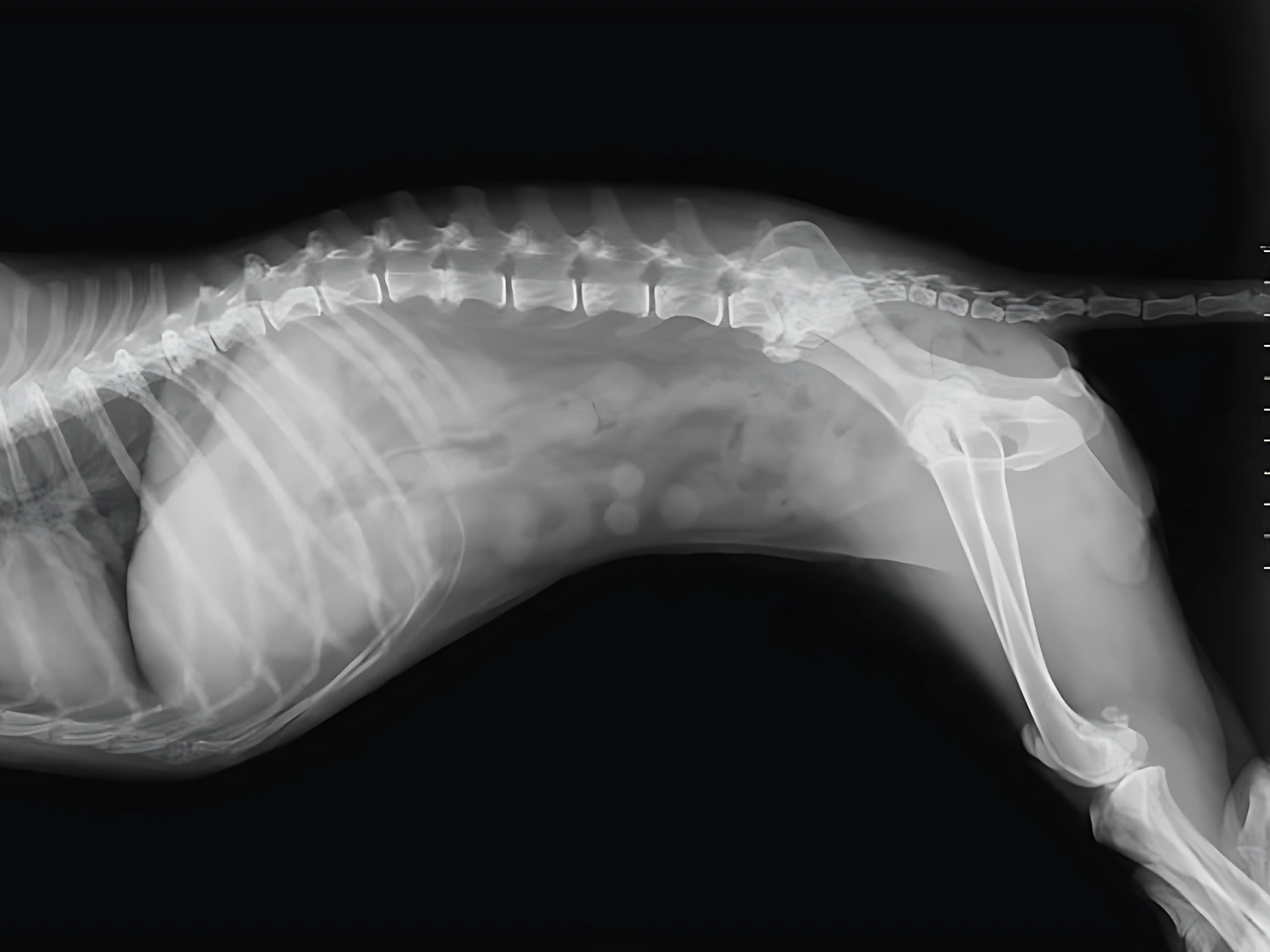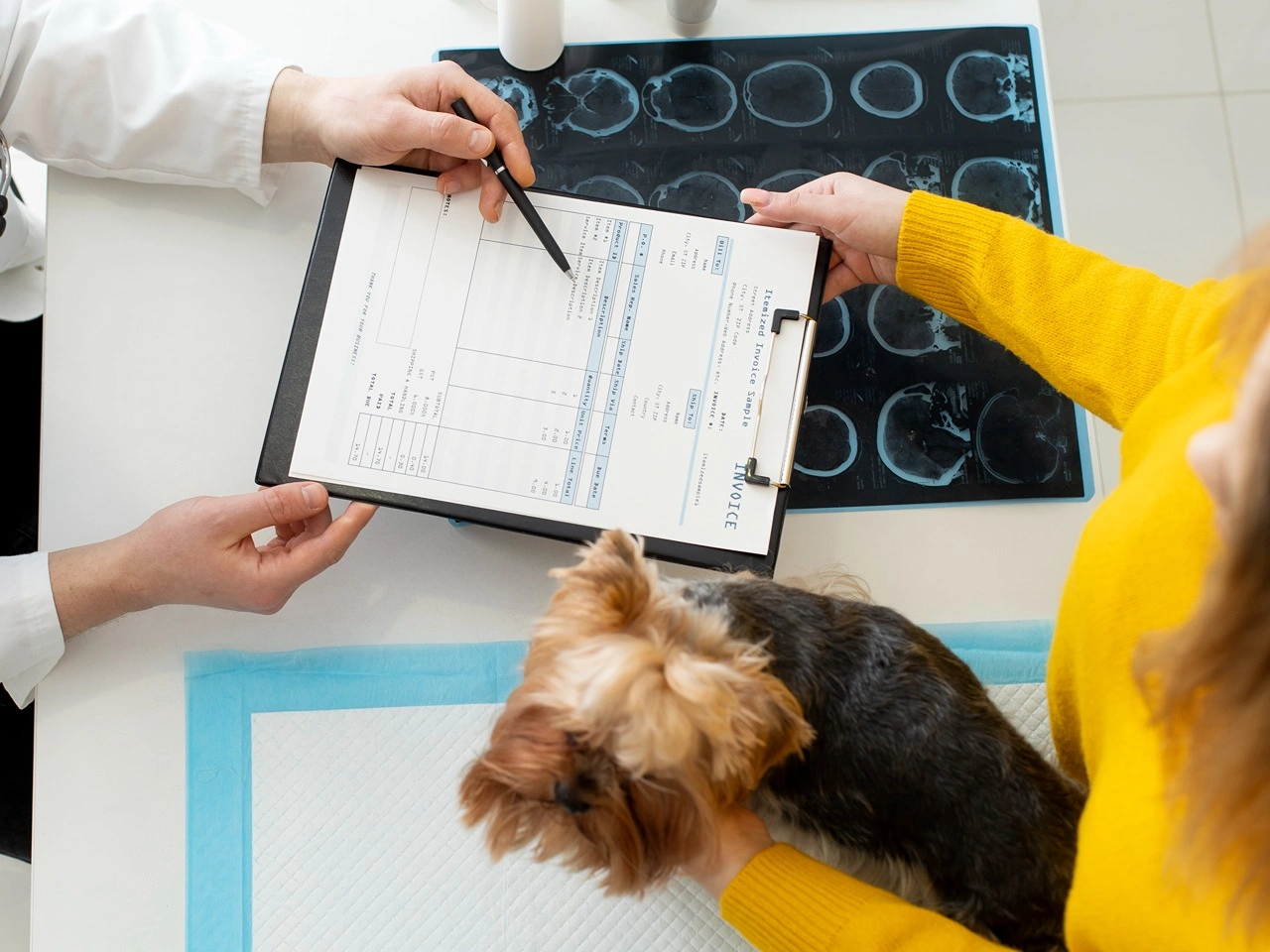TL;DR — Dog X-Rays: What to Expect, Why They're Needed, and How They Help
- Veterinarians use X-rays as a safe, non-invasive diagnostic tool to examine bones, joints, and internal organs
- Dogs may need an X-ray for symptoms like limping, vomiting, breathing issues, or after sudden trauma or accidents
- X-rays help detect fractures, foreign objects, bladder stones, or fluid buildup that aren’t visible during physical exams
- Sedation may be used to keep your dog still and calm, ensuring clearer imaging and reducing stress
- Digital X-rays provide fast, detailed results and may be followed by ultrasound if soft tissue detail is needed
- The number of images, area scanned, and procedure complexity can affect the overall cost and time involved
Not sure if your dog needs an X-ray? Reach out—we’ll help you understand what’s best for your dog.
Does your dog need an X-ray, and you’re unsure what to expect? In veterinary medicine, X-rays are commonly used by veterinarians as a diagnostic tool to examine your dog’s chest, abdomen, or limbs. Vets use state-of-the-art diagnostic imaging tools to detect conditions that aren’t visible on the surface.
Your veterinarian may recommend an X-ray to check for broken bones, bladder stones, foreign bodies, or fluid in the lungs. Sedation may be required to keep your dog calm during the x-ray procedure, especially if stillness is necessary for a clear x-ray. In some cases, imaging such as ultrasound could also be used to examine soft tissue or abdominal organs more closely.
X-rays help provide an accurate diagnosis by revealing tissue densities, internal organs, and areas of concern within the dog’s body. The use of X-ray technology allows veterinary clinics and animal hospitals to better understand your dog’s condition. Keep reading to learn how veterinarians explain the procedure, when sedation may be used, and how diagnostic x-rays play a vital role in your dog’s health.
Why and When Your Dog May Need an X-Ray

Veterinarians frequently use X-ray technology to glean information from within the body when a dog is in pain or showing unexplained symptoms. X-rays are generally used as a diagnostic tool in veterinary care to evaluate bones, joints, and internal organs without surgery. Whether your pet needs urgent care or routine evaluation, X-rays can help provide fast, accurate insights to guide treatment.
Signs Your Dog May Need an X-Ray
Pet parents should watch for symptoms that may indicate a deeper issue, requiring diagnostic tests such as X-rays:
- Limping or mobility issues – could mean broken bones or joint abnormalities.
- Abdominal discomfort or vomiting – may suggest ingestion of a foreign object.
- Coughing or laboured breathing – can point to fluid in the lungs or an enlarged heart.
- Urinary changes – often tied to bladder stones or kidney problems.
- Sudden trauma – after accidents, emergency veterinary x-rays are often needed.
In such cases, a veterinarian will be able to assess your dog’s condition more precisely using diagnostic imaging tools to diagnose conditions in dogs and cats.
How X-Rays Work and What They Reveal
Veterinary clinics frequently use X-rays to explore different areas of the body:
- An X-ray machine sends an X-ray beam through the body to capture images.
- Tissues absorb some X-rays depending on their density; the cranium absorbs all X-rays, creating a clear contrast.
- X-rays are captured on X-ray film or as a digital X-ray, depending on the technology used.
- These images help detect issues such as broken bones, foreign objects, enlarged organs, or fluid buildup.
Since radiation is involved, the procedure is done quickly and safely, often while the dog is calm or gently restrained.
When Ultrasound May Be Used Instead
While X-rays are typically used for bones and dense tissues, ultrasound could be used when soft tissues need closer inspection:
- Ultrasound uses sound waves instead of radiation.
- It provides real-time images of organs within the body.
- This method is typically used only occasionally, when X-rays don’t offer enough detail.
Your team of veterinary specialists may suggest a vet for a referral if further imaging is needed beyond the scope of routine care.
What to Expect When You Take Your Dog for Their X-ray Appointment

Taking your dog in for an X-ray might feel a little nerve-wracking, but the process is usually quick and straightforward. Vets generally use X-ray technology as a diagnostic tool when your dog is showing signs of pain or discomfort. With the right care and preparation, your dog will be in good hands.
How Your Vet Gets Ready for the X-Ray
- If your dog is in too much pain or has very little body fat, light sedation may be needed to help them stay calm and still.
- Vets will use X-ray technology to target the specific area of concern — whether it’s a leg, abdomen, or chest.
- Because radiation is involved, protective measures like lead aprons are used to keep everyone safe.
- The goal is to get a clear image the first time, so they don’t have to repeat the scan.
What Happens During the Scan
- Your dog will be gently positioned on the X-ray table while the machine directs an X-ray beam through the body.
- Dense areas like the cranium absorb all X-rays, while softer tissues absorb less — creating contrast in the image.
- Depending on the clinic, the images are captured using traditional X-ray film or modern digital X-ray systems.
- It’s all done in just a few minutes, with minimal discomfort for your pet.
What the X-Ray Can Show After the Scan
- X-rays can reveal broken bones, foreign objects, fluid buildup, and other issues that aren’t visible from the outside.
- They give your vet a clearer picture of what’s going on inside, which is especially important if your dog is very sick or injured.
- If more detailed views are needed, your vet may recommend other diagnostic tests like an ultrasound.
- It’s one of the most useful diagnostic tools in veterinary care, helping guide the right treatment plan quickly.
Other Factors to Keep in Mind
The number of images taken and the complexity of the issue can dictate the cost, even if the average cost isn’t discussed upfront. For pet parents, understanding the purpose and benefits of the procedure makes the visit more reassuring. Clear diagnostic imaging leads to better outcomes and faster relief for your dog.
The Benefits of X-rays in Veterinary Diagnostic Imaging

X-rays play a key role in veterinary care by helping veterinarians see inside a dog’s body without surgery. They are especially useful when a dog shows signs of illness or injury that aren’t visible from the outside.
- X-rays are fast, non-invasive tools that allow veterinarians to examine a dog’s bones, joints, and internal organs.
- They help detect conditions such as broken bones, bladder stones, tumours, and swallowed foreign objects.
- X-rays are generally used as a diagnostic tool to find the root cause of pain or illness in dogs and cats.
- Digital X-Rays produce high-quality images instantly, helping with quick decisions during emergency veterinary care.
- X-Rays can reveal problems in the lungs, heart, and abdomen that can’t be seen through physical exams alone.
- Veterinarians use X-Ray technology to glean information about soft tissue and tissue densities.
- When combined with other diagnostic tools like ultrasound, X-rays help provide a clearer picture of a pet’s health.
How Veterinarians Use X-ray or Ultrasound Based on Your Dog’s Needs

Veterinarians rely on both X-ray and ultrasound imaging as powerful diagnostic tools to better understand what's happening inside your dog’s body. The choice between these technologies depends on your dog’s symptoms, the area being examined, and what kind of detail is needed. Each method offers different insights to help guide proper veterinary care.
When Vets Choose X-Ray Technology
X-rays are typically used when a veterinarian needs a quick look at dense structures or when they suspect a foreign object might be causing discomfort. The X-Ray machine emits a beam that passes through the body, and denser tissues, like bone or metal, absorb more of the beam, appearing white on an X-Ray film or digital X-Ray image.
- Vets will use X-Ray technology to glean information about bones, lungs, joints, or potential blockages in the digestive system.
- X-rays are generally used as a diagnostic tool for conditions in dogs and cats involving fractures, arthritis, swallowed objects, or tumours.
- Because bones absorb more X-rays and show up clearly, X-ray imaging is often the first step in identifying orthopaedic issues.
- In emergency veterinary situations, X-rays can reveal internal trauma quickly and non-invasively.
When Ultrasound Is the Better Option
Ultrasound uses sound waves to produce live images of soft tissues and internal organs. It’s often used in combination with or as a follow-up to X-rays when further detail is needed within the body.
- Ultrasound could be used to examine organs such as the heart, liver, bladder, and uterus, especially when fluid, motion, or blood flow needs to be assessed.
- It’s a preferred method for abdominal scans, pregnancy checks, and detecting masses that aren’t visible on X-rays.
- For dogs with little body fat, ultrasound can provide clearer views of soft tissues than X-rays.
- Veterinarians may use both tools together when a deeper or more accurate diagnosis is needed.
How Your Dog’s Condition Influences the Choice
The right imaging tool depends on what your dog needs, how urgent the situation is, and how much pain they may be in.
- If your pet needs urgent care, a vet may prioritize X-Rays for fast results.
- Sedation may be recommended to ensure your dog is calm and still during the procedure, especially if much pain is present.
- A team of veterinary specialists may become involved if advanced imaging or interpretation is needed.
- Your regular vet may also refer you to an animal hospital for specialized scans.
A Pet Parent’s Guide to the Dog Xray Process

Taking your dog in for an X-Ray might feel overwhelming, especially if it’s your first time. Knowing what happens before, during, and after the procedure helps pet parents feel more prepared and confident. Whether it's a routine scan or an emergency, understanding the process makes a big difference in your dog’s care.
Before the Appointment
- Your vet may ask you to withhold food for a few hours before the scan, especially if sedation could be required.
- In emergency situations, X-Rays may be performed immediately without prep if the dog needs urgent care.
- Inform the vet of any signs of pain, anxiety, or conditions like heart disease that could influence sedation.
- For senior dogs or those with health complications, the vet may run basic blood tests beforehand to ensure it is safe to proceed.
- If your dog is very anxious, discuss calming options ahead of time to keep them relaxed and safe.
During the X-Ray
- Vets will use X-Ray technology to glean information from inside your dog’s body using a digital X-Ray machine or X-Ray film.
- A calm or lightly sedated dog produces clearer images and allows the X-Ray beam to capture specific areas of the body without distortion.
- Depending on your dog’s size and condition, the team may need to gently position them for multiple views.
- In cases involving trauma or a foreign object, multiple X-Rays may be needed to track its location.
- X-Rays are typically used for dogs and cats as a diagnostic tool to check for broken bones, joint issues, swallowed items, or abnormal masses.
After the Procedure
- The veterinarian will be able to review the images and may share initial findings with you right away.
- In complex cases, the scans might be sent to a radiologist or reviewed by a team of veterinary specialists.
- If further tests are needed, your vet may suggest an ultrasound or additional diagnostic imaging tools to diagnose specific conditions.
- For senior dogs or chronic issues, the results might be compared with previous scans to check progression.
- Your dog can usually go home the same day, and if sedation was used, they may be a bit drowsy for a few hours.
Final Thoughts
Dog X-rays are a reliable way to uncover health issues that are not visible on the surface. Knowing what to expect, including quick imaging, possible sedation, and same-day results, can help ease your worries.
Most procedures are simple and handled with care to keep your dog as comfortable as possible. If additional tests or views are needed, your veterinarian will walk you through the next steps.
Understanding the process helps you feel more prepared and confident about your dog’s care. If you have concerns or questions, reach out to us to make sure your pet receives the attention they need.
Frequently Asked Questions
How do I know if my dog needs an X-ray?
An X-ray may be necessary when your dog displays symptoms that suggest hidden injuries or internal issues. Consider:
Limping or mobility problems: Dogs showing stiffness or lameness may have fractures, arthritis, or joint abnormalities that require imaging.
Digestive or abdominal distress: Repeated vomiting, bloating, or visible discomfort may indicate ingestion of foreign objects or obstructions.
Respiratory symptoms: Coughing or breathing difficulties can point to fluid buildup, an enlarged heart, or lung disease.
Sudden accidents or trauma: After a fall or car accident, X-rays help detect internal damage even if there are no visible wounds.
How much does a dog X-ray cost at an animal hospital or veterinary clinic?
The cost of a dog X-ray depends on multiple factors, especially the type of clinic and specific imaging needs. Consider:
Procedure complexity: The number of X-ray views and whether sedation is needed will influence the total cost.
Type of facility: Emergency animal hospitals or specialty clinics may charge more than general veterinary practices.
Imaging technology used: Digital X-rays are often faster and clearer but may come at a higher price than traditional film.
Additional care: Follow-up testing or radiologist review may be billed separately from the initial imaging.
Does pet insurance cover dog X-rays?
Many pet insurance policies do include coverage for X-rays, particularly when used to diagnose illness or injury. Consider:
Accident or illness coverage: Most plans cover X-rays if they’re tied to an eligible health condition or emergency.
Policy details matter: Your coverage will depend on deductibles, annual limits, and exclusions stated in your plan.
Wellness plans vary: Routine or preventative X-rays are typically not covered under basic wellness packages.
Pre-approval may help: Some insurers require prior authorization for diagnostic imaging before reimbursement.
What factors affect the average cost of dog X-rays, and how can I plan ahead?
Understanding the elements that impact X-ray costs can help you prepare financially for your dog’s veterinary care. Consider:
Dog’s size and condition: Larger dogs may need stronger sedation or more image angles, which increases cost.
Urgency of care: Emergency or after-hours visits typically come with higher service fees.
Number of views required: Multiple images to assess different angles or locations can increase overall expense.
Added diagnostics: Radiology consultations or follow-up ultrasounds may be necessary for a complete diagnosis.
Why might a vet say your dog needs an X-ray during a check-up?
A vet may recommend an X-ray during a routine exam if they detect subtle signs of illness or abnormalities on physical inspection. Consider:
Abnormal sounds or swelling: Irregular breathing or heart sounds, or visible lumps, often prompt further investigation.
Change in weight or appetite: Unexplained weight loss or digestive issues may signal internal problems that X-rays can reveal.
Age-related concerns: Senior dogs may need imaging to monitor arthritis, organ changes, or long-term conditions.
Tracking health trends: X-rays can serve as a baseline or comparison tool for dogs with chronic or recurring issues.




